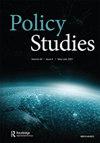实施数据驱动的竞选活动:设计一种新的工具,用于绘制和指导监管干预
IF 2.3
4区 管理学
Q2 PUBLIC ADMINISTRATION
引用次数: 0
摘要
自剑桥分析公司丑闻以来,各国政府越来越关注公民个人数据在竞选活动中被收集、处理和使用的方式。为了开发适当的工具来监控和控制这种“数据驱动的竞选”(DDC)的新模式,监管机构需要清楚地了解所涉及的做法。本文提出了一种新的以组织和过程为中心的DDC的操作定义,从中我们得出了一组经验指标,从而为实现这一目标迈出了第一步。这些指标被应用于该领域的主要政府——欧盟(EU)——的政策环境,以生成一个描述性的“热图”,说明当前针对DDC的监管活动。根据这项工作的结果,我们认为监管可能会加强现有的做法,并扩大到涵盖当前的“冷点”。根据互联网治理模型,我们认为这种扩张可能以两种方式之一发生。一种是“万花筒式”的方法,即当前的立法扩展到吸收DDC的做法,另一种是更“精心设计”的方法,即精英们更积极地干预,最终形成新的监管制度。本文章由计算机程序翻译,如有差异,请以英文原文为准。
Operationalizing data-driven campaigning: designing a new tool for mapping and guiding regulatory intervention
Since the Cambridge Analytica scandal, governments are increasingly concerned about the way in which citizens’ personal data are collected, processed and used during election campaigns To develop the appropriate tools for monitoring and controlling this new mode of “data-driven campaigning” (DDC) regulators require a clear understanding of the practices involved. This paper provides a first step toward that goal by proposing a new organizational and process-centred operational definition of DDC from which we derive a set of empirical indicators. The indicators are applied to the policy environment of a leading government in this domain – the European Union (EU) – to generate a descriptive “heat map” of current regulatory activity toward DDC. Based on the results of this exercise, we argue that regulation is likely to intensify on existing practices and extend to cover current “cold spots”. Drawing on models of internet governance, we argue that this expansion is likely to occur in one of two ways. A “kaleidoscopic” approach, in which current legislation extends to absorb DDC practices and a more “designed” approach that involves more active intervention by elites, and ultimately the generation of a new regulatory regime.
求助全文
通过发布文献求助,成功后即可免费获取论文全文。
去求助
来源期刊

Policy Studies
PUBLIC ADMINISTRATION-
CiteScore
5.40
自引率
4.50%
发文量
34
期刊介绍:
These changes at the structural level of the global system have impacted upon the work of public organizations either directly or indirectly and have broadened the field of action in policy studies. It has five main areas of intellectual interest: 1.To broaden the lens of policy analysis through the publication of research which locates policy-making within a theoretical, historical or comparative perspective. 2.To widen the field of enquiry in policy analysis through the publication of research that examines policy issues in a British, comparative, international or global context. 3.To promote constructive debate on theoretical, methodological and empirical issues in policy analysis.
 求助内容:
求助内容: 应助结果提醒方式:
应助结果提醒方式:


